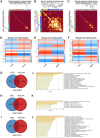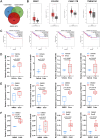Bioinformatics analysis reveals that CBX2 promotes enzalutamide resistance in prostate cancer
- PMID: 39175037
- PMCID: PMC11340159
- DOI: 10.1186/s40001-024-02021-0
Bioinformatics analysis reveals that CBX2 promotes enzalutamide resistance in prostate cancer
Abstract
Enzalutamide (Enz) is commonly utilized as the initial treatment strategy for advanced prostate cancer (PCa). However, a notable subset of patients may experience resistance to Enz, resulting in reduced effectiveness. Utilizing Gene Expression Omnibus (GEO) databases, we identified CBX2 as a crucial factor in mediating resistance to Enz, primarily due to its inhibitory effect on the P53 signaling pathway. Silencing of CBX2 using small interfering RNA (siRNA) led to elevated levels of P53 expression in LNCaP cells. This indicates that CBX2 may have a critical effect on PCa Enz resistance and could serve as a promising therapeutic target for individuals with Enz resistance.
Keywords: CBX2; Enzalutamide; PCa; Prostate cancer; Resistance.
© 2024. The Author(s).
Conflict of interest statement
There are no potential conflicts of interest.
Figures





Similar articles
-
Integrated bioinformatics analysis reveals that OPRK1 inhibits ferroptosis and induces enzalutamide resistance in prostate cancer.Eur J Med Res. 2025 Apr 15;30(1):279. doi: 10.1186/s40001-025-02484-9. Eur J Med Res. 2025. PMID: 40229787 Free PMC article.
-
SLC4A4 is a novel driver of enzalutamide resistance in prostate cancer.Cancer Lett. 2024 Aug 10;597:217070. doi: 10.1016/j.canlet.2024.217070. Epub 2024 Jun 14. Cancer Lett. 2024. PMID: 38880227
-
Identification of Potential Key Genes and Pathways in Enzalutamide-Resistant Prostate Cancer Cell Lines: A Bioinformatics Analysis with Data from the Gene Expression Omnibus (GEO) Database.Biomed Res Int. 2020 Jul 16;2020:8341097. doi: 10.1155/2020/8341097. eCollection 2020. Biomed Res Int. 2020. PMID: 32724813 Free PMC article.
-
The mechanism of histone modifications in regulating enzalutamide sensitivity in advanced prostate cancer.Int J Biol Sci. 2025 Apr 13;21(6):2880-2890. doi: 10.7150/ijbs.109638. eCollection 2025. Int J Biol Sci. 2025. PMID: 40303302 Free PMC article. Review.
-
ADT with antiandrogens in prostate cancer induces adverse effect of increasing resistance, neuroendocrine differentiation and tumor metastasis.Cancer Lett. 2018 Dec 28;439:47-55. doi: 10.1016/j.canlet.2018.09.020. Epub 2018 Sep 15. Cancer Lett. 2018. PMID: 30227222 Review.
Cited by
-
Unravelling the impact of the chromobox proteins in human cancers.Cell Death Dis. 2025 Apr 2;16(1):238. doi: 10.1038/s41419-025-07585-1. Cell Death Dis. 2025. PMID: 40175347 Free PMC article. Review.
References
MeSH terms
Substances
Grants and funding
LinkOut - more resources
Full Text Sources
Medical
Molecular Biology Databases
Research Materials
Miscellaneous

